Tissue distibution of murine Muc19/smgc gene products
- PMID: 19826070
- PMCID: PMC2803704
- DOI: 10.1369/jhc.2009.954891
Tissue distibution of murine Muc19/smgc gene products
Abstract
The recently identified gene Muc19/Smgc encodes two diverse splice variants, Smgc (submandibular gland protein C) and Muc19 (mucin 19). Muc19 is a member of the large gel-forming mucin family and is an exocrine product of sublingual mucous salivary glands in mice. SMGC is a transiently expressed secretion product of developing rodent submandibular and sublingual glands. Little is known about the expression of Muc19/Smgc gene products in other murine salivary and non-salivary tissues containing the mucous cell phenotype. Muc19 expression was therefore initially assessed by RT-PCR and immunohistochemistry. As a complementary approach, we developed a knockin mouse model, Muc19-EGFP, in which mice express a fusion protein containing the first 69 residues of Muc19 followed by enhanced green fluorescent protein (EGFP) as a marker of Muc19 expression. Results from both approaches are consistent, with preferential Muc19 expression in salivary major and minor mucous glands as well as submucosal glands of the tracheolarynx and bulbourethral glands. Evidence also indicates that individual mucous cells of minor salivary and bulbourethral glands produce another gel-forming mucin in addition to Muc19. We further find tissue expression of full-length Smgc transcripts, which encode for SMGC, and are restricted to neonatal tracheolarynx and all salivary tissues.
Figures
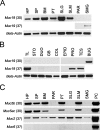

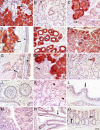
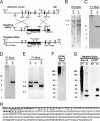

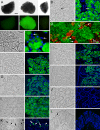

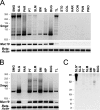
Similar articles
-
Expression of Muc19/Smgc gene products during murine sublingual gland development: cytodifferentiation and maturation of salivary mucous cells.J Histochem Cytochem. 2009 Apr;57(4):383-96. doi: 10.1369/jhc.2008.952853. Epub 2008 Dec 24. J Histochem Cytochem. 2009. PMID: 19110483 Free PMC article.
-
The gene encoding mouse Muc19: cDNA, genomic organization and relationship to Smgc.Physiol Genomics. 2004 Nov 17;19(3):303-18. doi: 10.1152/physiolgenomics.00161.2004. Epub 2004 Aug 31. Physiol Genomics. 2004. PMID: 15340121
-
Genome-wide search and identification of a novel gel-forming mucin MUC19/Muc19 in glandular tissues.Am J Respir Cell Mol Biol. 2004 Feb;30(2):155-65. doi: 10.1165/rcmb.2003-0103OC. Epub 2003 Jul 25. Am J Respir Cell Mol Biol. 2004. PMID: 12882755
-
Molecular cloning and characterization of the neonatal rat and mouse submandibular gland protein SMGC.Gene. 2004 Jun 9;334:23-33. doi: 10.1016/j.gene.2004.03.014. Gene. 2004. PMID: 15256252
-
Heterogeneity of high-molecular-weight human salivary mucins.Adv Dent Res. 2000 Dec;14:69-75. doi: 10.1177/08959374000140011101. Adv Dent Res. 2000. PMID: 11842927 Review.
Cited by
-
Cellular and molecular biology of airway mucins.Int Rev Cell Mol Biol. 2013;303:139-202. doi: 10.1016/B978-0-12-407697-6.00004-0. Int Rev Cell Mol Biol. 2013. PMID: 23445810 Free PMC article. Review.
-
Role of epithelial mucins during airway infection.Pulm Pharmacol Ther. 2012 Dec;25(6):415-9. doi: 10.1016/j.pupt.2011.12.003. Epub 2011 Dec 17. Pulm Pharmacol Ther. 2012. PMID: 22198062 Free PMC article. Review.
-
The sld genetic defect: two intronic CA repeats promote insertion of the subsequent intron and mRNA decay.J Biol Chem. 2013 May 24;288(21):14742-55. doi: 10.1074/jbc.M113.468645. Epub 2013 Apr 11. J Biol Chem. 2013. PMID: 23580649 Free PMC article.
-
The unfolded protein response and gastrointestinal disease.Semin Immunopathol. 2013 May;35(3):307-19. doi: 10.1007/s00281-013-0377-5. Epub 2013 Apr 16. Semin Immunopathol. 2013. PMID: 23588234 Free PMC article. Review.
-
Salivary gland function, development, and regeneration.Physiol Rev. 2022 Jul 1;102(3):1495-1552. doi: 10.1152/physrev.00015.2021. Epub 2022 Mar 28. Physiol Rev. 2022. PMID: 35343828 Free PMC article. Review.
References
-
- Ball WD, Hand AR, Moreira JE, Johnson AO (1988) A secretory protein restricted to type I cells in neonatal rat submandibular glands. Dev Biol 129:464–475 - PubMed
-
- Ball WD, Redman RS (1984) Two independently regulated secretory systems within the acini of the submandibular gland of the perinatal rat. Eur J Cell Biol 33:112–122 - PubMed
-
- Bendtsen JD, Nielsen H, von Heijne G, Brunak S (2004) Improved prediction of signal peptides: SignalP 3.0. J Mol Biol 340:783–795 - PubMed
-
- Chen J, Sun M, Hurst LD, Carmichael GG, Rowley JD (2005) Genome-wide analysis of coordinate expression and evolution of human cis-encoded sense-antisense transcripts. Trends Genet 21:326–329 - PubMed
-
- Culp DJ, Latchney LR, Fallon M, Denny PA, Couwenhoven PC, Sally RI, Chuang S (2004) The gene encoding mouse Muc19: cDNA, genomic organization and relationship to Smgc. Physiol Genomics 19:303–318 - PubMed
Publication types
MeSH terms
Substances
Grants and funding
LinkOut - more resources
Full Text Sources
Molecular Biology Databases
Research Materials

